Related Research Articles

Palaeotherium is an extinct genus of equoid that lived in Europe and possibly the Middle East from the Middle Eocene to the Early Oligocene. It is the type genus of the Palaeotheriidae, a group exclusive to the Palaeogene that was closest in relation to the Equidae, which contains horses plus their closest relatives and ancestors. Fossils of Palaeotherium were first described in 1782 by the French naturalist Robert de Lamanon and then closely studied by another French naturalist, Georges Cuvier, after 1798. Cuvier erected the genus in 1804 and recognized multiple species based on overall fossil sizes and forms. As one of the first fossil genera to be recognized with official taxonomic authority, it is recognized as an important milestone within the field of palaeontology. The research by early naturalists on Palaeotherium contributed to the developing ideas of evolution, extinction, and succession and demonstrating the morphological diversity of different species within one genus.
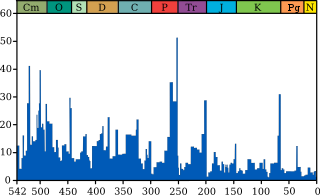
The Eocene–Oligocene extinction event, also called the Eocene-Oligocene transition (EOT) or Grande Coupure, is the transition between the end of the Eocene and the beginning of the Oligocene, an extinction event and faunal turnover occurring between 33.9 and 33.4 million years ago. It was marked by large-scale extinction and floral and faunal turnover, although it was relatively minor in comparison to the largest mass extinctions.

Anoplotherium is the type genus of the extinct Palaeogene artiodactyl family Anoplotheriidae, which was endemic to Western Europe. It lived from the late Eocene to the earliest Oligocene. It was the fifth fossil mammal genus to be described with official taxonomic authority, with a history extending back to 1804 when its fossils from Montmartre in Paris, France were first described by the French naturalist Georges Cuvier. Discoveries of incomplete skeletons of A. commune in 1807 led Cuvier to thoroughly describe unusual features for which there are no modern analogues. His drawn skeletal and muscle reconstructions of A. commune in 1812 were amongst the first instances of anatomical reconstructions based on fossil evidence. Cuvier's contributions to palaeontology based on his works on the genus were revolutionary for the field, not only proving the developing ideas of extinction and ecological succession but also paving the way for subfields such as palaeoneurology. Today, there are four known species.

The Jebel Qatrani Formation is a geologic formation located in the Faiyum Governorate of central Egypt. It is exposed between the Jebel Qatrani escarpment and the Qasr el Sagha escarpment, north of Birket Qarun lake near Faiyum. The formation conformably overlies the Qasr el Sagha Formation and is topped by the Widan el Faras Basalt. The age of the formation has been subject to debate, but the most recent research indicates that it covers both the latest parts of the Eocene and the Early Oligocene, spanning over the boundary between these two time periods.

Palaeogale is an extinct genus of carnivorous mammal known from the Late Eocene, Oligocene, and Early Miocene of North America, Europe, and Eastern Asia. A small carnivore often associated with the mustelids, Palaeogale might have been similar to living genets, civets, and linsangs.

Pterodon is an extinct genus of hyaenodont in the family Hyainailouridae, containing five species. The type species Pterodon dasyuroides is known exclusively from the late Eocene to the earliest Oligocene of western Europe. The genus was first erected by the French zoologist Henri Marie Ducrotay de Blainville in 1839, who said that Georges Cuvier presented one of its fossils to a conference in 1828 but died before he could make a formal description of it. It was the second hyaenodont genus with taxonomic validity after Hyaenodon, but this resulted in taxonomic confusion over the validities of the two genera by other taxonomists. Although the taxonomic status of Pterodon was revised during the late 19th and early 20th centuries, it became a wastebasket taxon for other hyaenodont species found in Africa and Asia. Today, only the type species is recognized as belonging to the genus while four others are pending reassessment to other genera.
Duerotherium is an extinct genus of Palaeogene artiodactyls known only from the Iberian Peninsula during the Middle Eocene, which contains one species D. sudrei. It, like other members of the Anoplotheriidae, was endemic to Western Europe. The anoplotheriine was described from a left fragment of a maxilla from the Mazaterón Formation of the Duero Basin in 2009. Its dentition is mostly typical of the Anoplotheriinae but differs by an elongated plus triangular 3rd upper premolar and very specific traits of the molars. It is thought to have been part of an endemic faunal assemblage that evolved within the Iberian Peninsula by the Middle Eocene, where climates were subtropical.

Xiphodon is the type genus of the extinct Palaeogene artiodactyl family Xiphodontidae. It, like other xiphodonts, was endemic to Western Europe and lived from the middle Eocene up to the earliest Oligocene. Fossils from Montmartre in Paris, France that belonged to X. gracilis were first described by the French naturalist Georges Cuvier in 1804. Although he assigned the species to Anoplotherium, he recognized that it differed from A. commune by its dentition and limb bones, later moving it to its own subgenus in 1822. Xiphodon was promoted to genus rank by other naturalists in later decades. It is today defined by the type species X. gracilis and two other species, X. castrensis and X. intermedium.

Plagiolophus is an extinct genus of equoids belonging to the family Palaeotheriidae. It lived in Europe from the middle Oligocene to the early Oligocene. The type species P. minor was initially described by the French naturalist Georges Cuvier in 1804 based on postcranial material including a now-lost skeleton originally from the Paris Basin. It was classified to Palaeotherium the same year but was reclassified to the subgenus Plagiolophus, named by Auguste Pomel in 1847. Plagiolophus was promoted to genus rank by subsequent palaeontologists and today includes as many as seventeen species. As proposed by the French palaeontologist Jean A. Remy in 2004, it is defined by three subgenera: Plagiolophus, Paloplotherium, and Fraasiolophus.
This paleomammalogy list records new fossil mammal taxa that were described during the year 2013, as well as notes other significant paleomammalogy discoveries and events which occurred during that year.
This paleomammalogy list records new fossil mammal taxa that were described during the year 2010, as well as notes other significant paleomammalogy discoveries and events which occurred during that year.
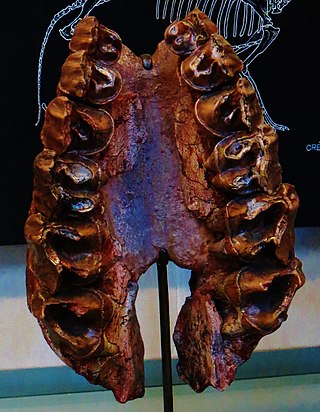
Ronzotherium is an extinct genus of perissodactyl mammal from the family Rhinocerotidae. The name derives from the hill of 'Ronzon', the French locality near Le Puy-en-Velay at which it was first discovered, and the Greek suffix 'therium' meaning 'beast'. At present 5 species have been identified from several localities in Europe and Asia, spanning the Late Eocene to Upper Oligocene.
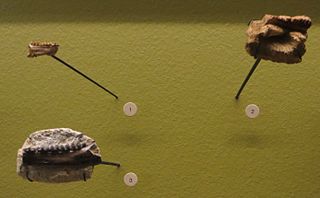
Dichodon is an extinct genus of Palaeogene artiodactyls belonging to the family Xiphodontidae. It was endemic to Western Europe and lived from the middle Eocene up to the earliest Oligocene. The genus was first erected by the British naturalist Richard Owen in 1848 based on dental remains from the fossil beds in Hordle, England. He noticed similar dentitions to contemporary artiodactyls like those of the Anoplotheriidae and Dichobunidae and references the name of the genus Dichobune. Eventually, it was found to be more closely related to Xiphodon and now includes 11 species, although one of them may be synonymous.

Bachitherium is an extinct genus of Paleogene ruminants that lived in Europe from the late Eocene to the late Oligocene. The genus was erected in 1882 by Henri Filhol based on fossil remains found in the Quercy Phosphorites Formation. Bachitherium curtum was defined the type species, and another species called B. insigne; five more species have since been named although one, B. sardus, is currently pending reassessment. The genus name derives from "Bach", the French locality where its first fossils were found, and the Greek θήρ/therium meaning "beast". Bachitherium has historically been assigned to various families within the ruminant infrorder Tragulina, but was reclassified to its own monotypic family Bachitheriidae by Christine Janis in 1987.
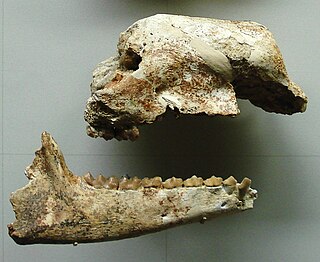
Diplobune is an extinct genus of Palaeogene artiodactyls belonging to the family Anoplotheriidae. It was endemic to Europe and lived from the late Eocene to the early Oligocene. The genus was first erected as a subgenus of Dichobune by Ludwig Rütimeyer in 1862 based on his hypothesis of the taxon being a transitional form between "Anoplotherium" secundaria, previously erected by Georges Cuvier in 1822, and Dichobune. He based the genus etymology off of the two-pointed pillarlike shapes of the lower molars, which had since been a diagnosis of it. However, in 1870, Diplobune was elevated to genus rank by Oscar Fraas, who recognized that Diplobune was a distinct genus related to Anoplotherium and not Dichobune. After several revisions of the anoplotheriids, there are currently four known species of which D. minor is the type species.
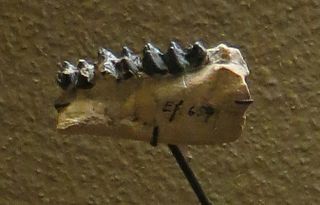
Catodontherium is an extinct genus of Palaeogene artiodactyls belonging to the family Anoplotheriidae. It was endemic to Western Europe and had a temporal range exclusive to the middle Eocene, although its earliest appearance depends on whether C. argentonicum is truly a species of Catodontherium. It was first named Catodus by the French palaeontologist Charles Depéret in 1906, who created two species for the genus and later changed the genus name to Catodontherium in 1908. The Swiss palaeontologist Hans Georg Stehlin renamed one species and classified two other newly erected species to Catodontherium in 1910. Today, there are four known species, although two remain questionable in genus placement.
Ephelcomenus is an extinct genus of Palaeogene artiodactyls endemic to Western Europe. It contains one species E. filholi, which was first described by Richard Lydekker in 1889 but eventually classified to its own genus by the Swiss palaeontologist Johannes Hürzeler in 1938. It has an uncertain stratigraphic range, but some sources suggest that it was present in the Oligocene after the Grande Coupure turnover event of western Europe.
Robiatherium is an extinct genus of Palaeogene artiodactyls containing one species R. cournovense. The genus name derives from the locality of Robiac in France where some of its fossil were described plus the Greek θήρ/therium meaning "beast" or "wild animal". It was known only from the middle Eocene and, like other anoplotheriids, was endemic to Western Europe. The genus was erected by Jean Sudre in 1988 for a species originally attributed to the xiphodont genus Paraxiphodon in 1978. Robiatherium had dentitions typical of the subfamily Anoplotheriinae, differing from other genera by specific differences in the molars. It is one of the earliest-appearing anoplotheriine species in the fossil record as well as the earliest to have appeared in Central Europe.
Haplomeryx is an extinct genus of Palaeogene artiodactyls belonging to the family Xiphodontidae. It was endemic to Western Europe and lived from the middle Eocene up to the earliest Oligocene. Haplomeryx was first established as a genus by the German naturalist Max Schlosser in 1886 based on a molar tooth set from Quercy Phosphorites deposits. Three additional species were erected and classified to the xiphodontid genus while one other species, first recognized in 1822, was tentatively classified to it and remains unresolved in affinity.

Amphimeryx is an extinct genus of Palaeogene artiodactyls belonging to the family Amphimerycidae that was endemic to the central region of western Europe and lived from the Late Eocene to the Early Oligocene. It was erected in 1848 by the French palaeontologist Auguste Pomel, who argued that its dentition was roughly similar to those of ruminants. Hence, the etymology of the genus name means "near ruminant," of which it derives from the ancient Greek words ἀμφί (near) and μήρυξ (ruminant). The type species A. murinus was previously recognized as a species of Dichobune by the French palaeontologist Georges Cuvier in 1822 before its eventual reclassification to its own genus. Two other species A. collotarsus and A. riparius are recognized also today although the former may be synonymous with A. murinus while the latter is known solely by a now-lost fossil specimen.
References
- 1 2 Tissier, Jérémy; Becker, Damien; Codrea, Vlad; Costeur, Loïc; Fărcaş, Cristina; Solomon, Alexandru; Venczel, Marton; Maridet, Olivier (18 April 2018). "New data on Amynodontidae (Mammalia, Perissodactyla) from Eastern Europe: Phylogenetic and palaeobiogeographic implications around the Eocene-Oligocene transition". PLOS ONE. 13 (4): e0193774. Bibcode:2018PLoSO..1393774T. doi: 10.1371/journal.pone.0193774 . PMC 5905962 . PMID 29668673.
- ↑ Koch, A (1897). "Prohyracodon orientalis, ein neues Ursaugethier aus den mitteleocenen Schichten Siebenbürgens". Természetrajzi Füzetek. 20: 481–500.
- ↑ Kretzoi, M (1940). "Alttertiäre Perissodactylen aus Ungarn". Annales historico-naturales Musei nationalis hungarici. 33: 87–98.
- ↑ Nikolov, Ivan; Heissig, Kurt (1985). "Fossile Säugetiere aus dem Obereozän und Unteroligozän Bulgariens und ihre Bedeutung für die Palaeogeographie". Mitteilungen der Bayerischen Staatssammlung für Paläontologie und historische Geologie. 25: 61–79.
- ↑ Grandi, Federica; Bona, Fabio (September 2017). "Prominatherium dalmatinum from the late Eocene of Grancona (Vicenza, NE Italy). The oldest terrestrial mammal of the Italian peninsula". Comptes Rendus Palevol. 16 (7): 738–745. doi: 10.1016/j.crpv.2017.04.002 . hdl: 2434/891025 .
- 1 2 Licht, Alexis; Métais, Grégoire; Coster, Pauline; İbilioğlu, Deniz; Ocakoğlu, Faruk; Westerweel, Jan; Mueller, Megan; Campbell, Clay; Mattingly, Spencer; Wood, Melissa C.; Beard, K. Christopher (1 March 2022). "Balkanatolia: The insular mammalian biogeographic province that partly paved the way to the Grande Coupure" (PDF). Earth-Science Reviews. 226: 103929. Bibcode:2022ESRv..22603929L. doi:10.1016/j.earscirev.2022.103929.
- ↑ Mennecart, Bastien; Radović, Predrag (2018). "New data on the earliest European ruminant (Mammalia, Artiodactyla): A revision of the fossil mandible from Rusce in the Pčinja basin (late Eocene, Southeastern Serbia)". Palaeontologia Electronica. 21 (3). doi: 10.26879/883 .
- ↑ de Bruijn, Hans; Marković, Zoran; Wessels, Wilma; Milivojević, Miloš; van de Weerd, Andrew A. (1 September 2018). "Rodent faunas from the Paleogene of south-east Serbia". Palaeobiodiversity and Palaeoenvironments. 98 (3): 441–458. doi:10.1007/s12549-017-0305-0. PMC 6417383 . PMID 30956713.